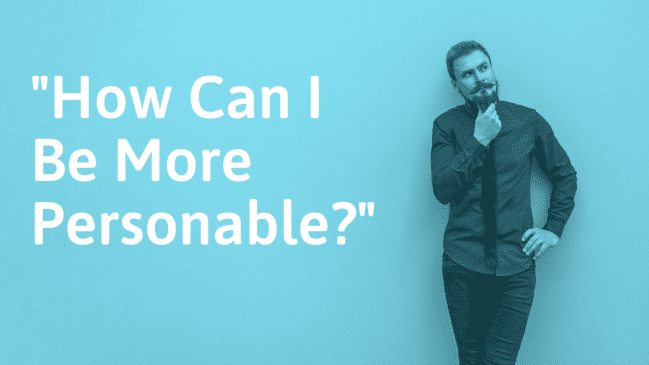This article is for you, someone who wants to have a more personable demeanor in social situations. Perhaps you work in a job where you have to interact with the public, and you want to improve your social skills. There may be other everyday situations where you want to come across as more personable and likable, such as with new people or at a job interview.
What does it mean to be personable?
Someone who is personable is a likable person who others enjoy being around. Being personable can mean many different things, such as being friendly, open, warm, and generous.
Is being personable a skill?
Yes. A personable demeanor is a great foundation for other people skills. It’s a talent you can develop, even if it doesn’t feel natural at first.
Being more personable
Improve your social skills to become more personable. Having more of these skills tends to lead to more satisfying social lives, and often makes us more likable.[1] Improving your social skills is a task you work on over time, but I will be giving you some tools to get you off to a solid beginning. Here are my steps for how to be personable:
1. Practice expressing your emotions
If you are excited or happy, practice conveying those emotions. Do it in a natural way that feels authentic to you. Showing emotions can make us feel self-conscious at first, but is an important part of forming connections with others.
If you feel stiff around others, think about how you would express yourself if there was no one around to judge you. You can take small steps toward behaving more like that, even if it’s hard at first.
2. Pay attention to others body language and tone
How well do you pick up on non-verbal information from others? Pay attention to subtle cues in people’s behavior, such as how they stand or what they do with their hands when speaking. Over time you’ll be able to pick up more information about people’s body language.
Picking up on people’s subtle signals will help you fine-tune your social behavior and avoid coming off as off-beat.
See this guide from Verywell Mind on how to pick up on body language.
3. Control your emotions
Practice your ability to control and regulate your emotions. Sometimes, we need to get along with people we don’t like and curb our instinctive emotional response. At other times, we might need to curb an urge to tell a story if that could lead us to interrupt someone.
This article from Healthline goes in-depth into how to regulate your emotions.
4. Engage with people you come across
Practice your ability to be friendly and engage others.
This includes:
- Asking friendly questions such as “How have you been since last time” or “Good to see you!”
- Taking the initiative to walk up to people or keep in touch with someone you get along with
- Showing appreciation such as “You did a great presentation” or “I like your jacket.”
These types of actions tend to come easier to extroverts, but we introverts can learn them too by paying extra attention to them.
When you are interacting with others, practice taking small steps outside of your normal behavior to interact with people. It might get awkward at first before you get comfortable with it, and that’s OK. You can choose to see it as a learning experience.
5. Pay attention to social norms
Social norms are all the unwritten rules and assumptions about how to act when socializing. The best way to learn the social norms if you’re uncertain is to watch other people: Analyze socially savvy people around you for tips on how to tackle different situations.
6. Be able to adjust to different types of social situations
Personable people are able to adjust their behavior to what’s appropriate to the social situation. This is called rapport-building and helps you form connections with more types of people in more types of situations.[2]
Rapport involves everything from what topics you choose to talk about to your body language. Read our full guide here: How to build rapport.
7. Study how to use personable body language
What message are you sending out through your non-verbal communication? Personable people usually have a friendly and open body language. This includes:
- Smiling
- Direct eye contact, shifting your gaze every once in a while
- Tilting your head a little to show empathy
- Avoiding getting distracted when speaking with someone
- Using open body language – no crossing your legs or arms
- Nodding in agreement/understanding
- Having an upright posture
- Relaxing your facial expression
8. Practice your empathy
Part of being personable and likable is showing understanding towards other people. Human beings appreciate it when others show kindness to their situation. A small exercise to build your empathy is as follows:
Think of a person that you know, or it can be someone you’re in a conversation with. Pay attention to their general demeanor, mood, and tone. Try to envision how they might be feeling right now. Then think of what reasons may be behind this feeling. Doing this exercise helps you be more aware of other’s emotions.
9. Step outside yourself and analyze the situation
One way that can help you be aware of your own behavior in a social situation is mindfulness. This means focusing on the present moment and becoming very aware of what you’re feeling, doing, and what’s going through your mind. Notice how people react to you when you do and say different things.
Here’s an exercise you can do during your next social interaction: Pay attention to subtle feelings you experience, without judging them or trying to change them. How do these feelings change throughout your social interaction?
This exercise can make you more aware of how yours’ and others’ behavior affects your emotions.
10. Listen closely
Personable people are usually good listeners. Practice active listening. When you actively listen, you listen in order to hear what the other person has to say, rather than to jump in with your own comment.
If you notice that you start formulating your next sentence when someone is talking, move your attention back to what they are saying. Try to focus on the message and come up with follow-up questions.
11. Ask questions
In order to listen, you have to get people talking. A good conversationalist usually asks open-ended questions. Instead of asking, “Did you enjoy your trip to Europe?” which is a yes or no question, you can ask “So what were your impressions of Europe?’. This is an open question which gives the person a lot of choice about their answer. Not every question has to be an open-ended question, but you can try to ask more of these questions if you feel that your conversations tend to die out.
Ask clarifying questions to signal that you’re interested in what they say. Doing so makes it more rewarded talking to you. “So did you ever get the wallet back?” “What did she say when you came back?”
12. Remember what people tell you
Just as important as listening well is remembering what people have told you. People are usually thrilled to be asked about something previously discussed, as it indicates that you listened to them and cared about what they were saying.
“You mentioned that you were going for a hike, how was it?”
“Are you feeling better or do you still have a cold?”
13. Show people that you like them
We are more inclined to like people when we think they like us. This is called reciprocity of liking.[3] When you take a friendly attitude toward others and make it clear that you approve of them, they will probably like you in return.
You can show people that you like them by:
- Smiling at them and using open body language
- Complimenting them on something they’ve done
- Doing them a small favor
- Asking them thoughtful questions that show you care about their experiences and opinions
14. Accept people for who they are
When you respect that everyone has the right to be themselves, you’ll find it easier to be friendly and personable. Let other people speak their minds even when you disagree. Respect their decisions when it comes to how they talk, dress, and spend their time.
Research has found that agreeableness, tolerance, and empathy go together. These findings mean that developing your empathy skills can help you be accepting.[4]
When talking to someone who appears very different to you, aim to learn about them and their life instead of judging them. Pretend you are an anthropologist and let yourself be curious.
15. Use humor
If you make people laugh, there’s a good chance they will like you. Laughter releases feel-good chemicals called endorphins, which promote a sense of bonding between two people.[5] Assuming they aren’t offensive, it’s also a good idea to laugh at everyone else’s jokes. It can make you appear friendlier and confirms that you have a sense of humor.
Until you know someone well, stick to safe humor that doesn’t poke fun at anyone else. Avoid joking about potentially controversial topics, like politics and religion.
Some of us are naturally funnier than others, but using humor is a skill. With practice, you can become better at making jokes and witty observations. Check out this guide on how to be funny in conversation.
16. Share something about yourself
When you share some personal details about yourself or your life, you make yourself vulnerable in front of other people. This can make you more likable because it shows that you trust them. Disclosure also encourages others to share something in return, which can deepen your relationship.
However, it’s best to avoid intimate details if you haven’t known the other person very long. Let them get to know you, but avoid talking in depth about medical conditions, relationships, or deeply held beliefs on religion and politics.
The F.O.R.D. acronym is a good guide: in most cases, it’s safe to talk about Family, Occupation, Recreation, and Dreams (e.g., ideal jobs and dream vacations).
17. Compliment people
When you say something positive about another person, they will attribute the same quality to you. This effect has been demonstrated in three separate scientific studies[6] and is known as “trait transference.” For example, if you compliment someone on their upbeat attitude, they will start to think of you in the same way. Be careful not to overdo compliments, because giving too many can make you come across as insincere.
Being personable in different situations
You may want to learn how to be personable in various settings, including work, social gatherings, on the phone, or in an interview.
The way you apply the advice in this article will vary in different contexts. You will need to read the room and understand social norms. For example, it wouldn’t be appropriate to share personal information at a job interview or ask your boss questions about their private life.
How to be personable at work
Working with customers entails being friendly, smiling, and using positive body language. You can occasionally give compliments that are not too personal, such as, “I like your bag!” Do not ask personal questions or share private information about yourself.
Unless they are also your friends, the same is true of working with colleagues. In both cases, you need to maintain clear professional boundaries.
How to be personable on the phone
What you say and your tone of voice is key. Use an upbeat or calm tone of voice, depending on the topic of conversation. Remember that the other person cannot see your facial expressions or body language, so you may have to spell out your reactions and feelings.
Being your best self during an interview
Keep your body language confident and friendly. Stand or sit up straight, look the interviewer in the eye when you speak, and smile. Ask questions about the company and the position, but avoid personal topics.
How to be personable in a group
If you are standing or sitting with other people, laugh with others, and nod when someone is talking. This consolidates your presence in the group.
Asking the group some questions is a great way to appear personable and to get people talking to each other. Group situations aren’t usually the right setting for in-depth conversations, but you can still take the opportunity to show sincere interest in the people you meet.
See this article for more advice about how to be included in a group conversation.
How to be personable when you’re having a one-on-one conversation
When you’re speaking with one person alone, you can be more personal than when you’re in a group with everyone listening. You can ask more questions and reveal more personal information about yourself. This can build trust between you. It’s a good opportunity to get closer to another person.
Read books on how to be personable
There are lots of books on how to be personable available online.
Here are 3 of the best:
1. How to Make People Like You in 90 Seconds or Less
This book will show you how to quickly build rapport with anyone. When you’ve mastered this skill, you’ll appear more personable.
2. PeopleSmart: Developing Your Emotional Intelligence
If you want to learn how to be assertive, understand people, and develop empathy, this book will help you. It contains lots of exercises that show you how to put these skills into practice.
3. The Charisma Myth: How Anyone Can Master the Art and Science of Personal Magnetism
The Charisma Myth shows you why and how everyone can learn to be engaging and personable. It includes useful strategies you can start applying immediately.











David, you always do your homework before you put anything out, I must say
that. Very organized and easy to read. I printed what you sent me and will
read it when I have the time, which is probably never since I hardly read one page or two of the course I took. Most of the questions you put there are like
addressed to me and probably to most of us.
Anyway, I will probably enjoy reading what I printed during the week end
hopefully. This little chit- chat to say thank you for the e-mail. Good to hear
from you. Anne